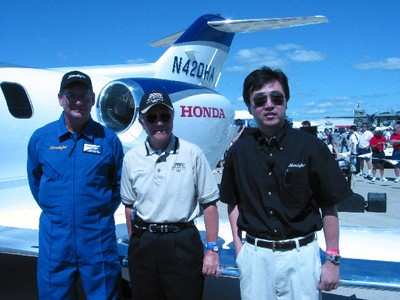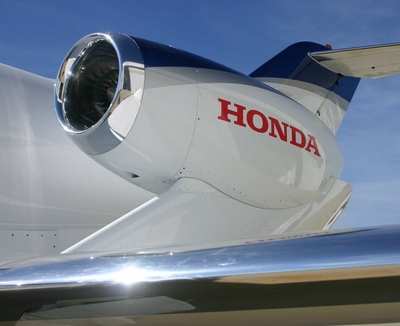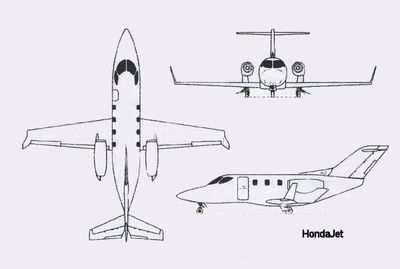Experimental Aircraft Testing Many Honda Innovations
By Ann Correspondent Christopher Armstrong
Honda Motor Co. Ltd. unraveled the shroud of secrecy surrounding
its experimental jet at Airventure 2005 in Oshkosh, WI, flying the
Hondajet in from its home base at Piedmont Triad Airport in
Greensboro, NC.

"This public world debut of the HondaJet represents the
continued advancement of Honda's long-standing dream of aviation,"
said Michimasa Fujino, HondaJet project leader and vice president
of Honda R&D Americas, Inc. "We are pleased and excited to be
able to share this dream and our technology with the aviation
community."

First flown in 2003, the Hondajet made its world debut at
Oshkosh, taking a short break during its planed 200 hour flight
test program. The 6 seat Hondajet is powered by two HF118
engines developed by Honda. These very fuel efficient
high-bypass turbo fans produce 757 pounds of thrust each and are
mounted on a strut projecting up from the wing.

This design increases Cabin volume by eliminating the need for
engine mounting structure in the aft fuselage, and increases the
drag divergence Mach number which reduces drag at high speed.
With a 420 knot maximum speed the Hondajet is designed to be faster
and more 40% more fuel efficient and 30% more spacious than current
light jets.
This over-the-wing engine-mount design is one of several
innovations in the Hondajet that has been computer optimized to
increase the aircrafts performance. Honda R&D Americas
project leader Michimasa Fujino presented a forum in the Honda
Motorcycles Pavilion Thursday after the aircraft arrived.

The aircraft utilizes a custom natural laminar flow airfoil for
its wing. Honda's proprietary SMH-1 wing section achieves low drag
and excellent performance at high speeds despite its relatively
high 15% chord thickness. Typical business jet airfoils are 9
to 12% thick. The SMH-1 achieves laminar flow over the forward 42
percent of its upper surface and 63 percent of the lower
surface.

Honda developed the airfoil using CFD methods, wind tunnel
tested it and then test flew it on a T-33 by using a glove over the
wing. In order to realize the benefits of the laminar flow section
the wing must be manufactured with an extremely accurate and smooth
surface. Honda used an integrally stiffened one piece skin in
the all aluminum wing.
The fuselage nose has also been designed to maintain laminar
flow, which is a more difficult problem due to the 3 dimensional
shape of the flow. To achieve laminar three dimensional flows, not
only must the adverse pressure gradient need to be minimized but
the design must maintain straight streamlines to eliminate cross
flow. The fuselage nose and tail use honeycomb cores while
the constant section element is a co-cured panel with stiffening
ribs and stringers. This combination of structural methods
reduced weight and increased interior space.

For a research aircraft the Hondajet has an extremely well
equipped instrument panel. A Garmin G1000 glass cockpit system is
used to present information on flat-panel flight displays. The
Hondajet was displayed briefly at the center of Aeroshell Square
and then moved to a hanger to prepare it for return to North
Carolina.
 Airborne-NextGen 11.04.25: Anduril YFQ-44A, Merlin SOI 2, UAV Rulemaking Stalled
Airborne-NextGen 11.04.25: Anduril YFQ-44A, Merlin SOI 2, UAV Rulemaking Stalled NTSB Prelim: Elmore Travis C Searey
NTSB Prelim: Elmore Travis C Searey ANN's Daily Aero-Linx (11.03.25)
ANN's Daily Aero-Linx (11.03.25) ANN's Daily Aero-Term (11.03.25): On-Course Indication
ANN's Daily Aero-Term (11.03.25): On-Course Indication Aero-News: Quote of the Day (11.03.25)
Aero-News: Quote of the Day (11.03.25)








